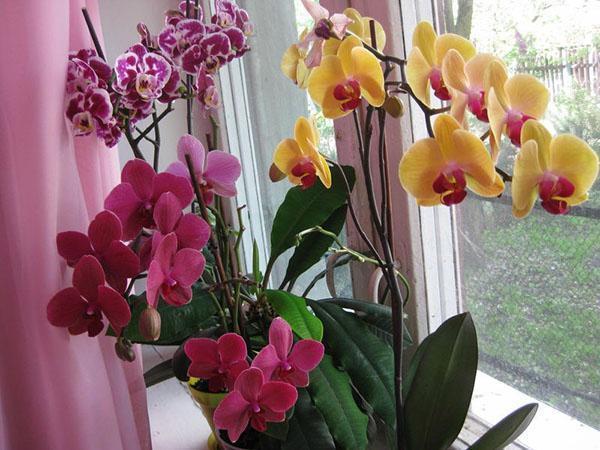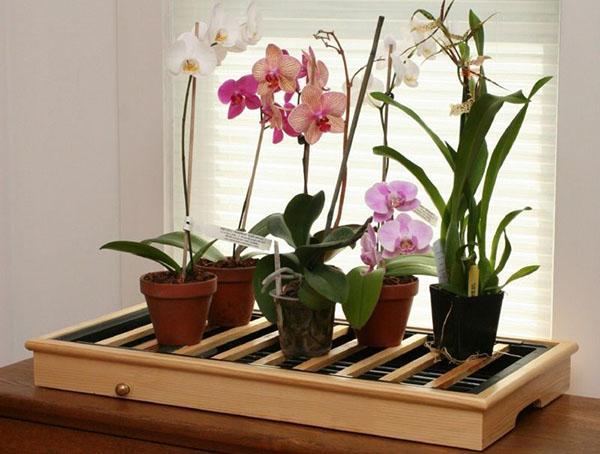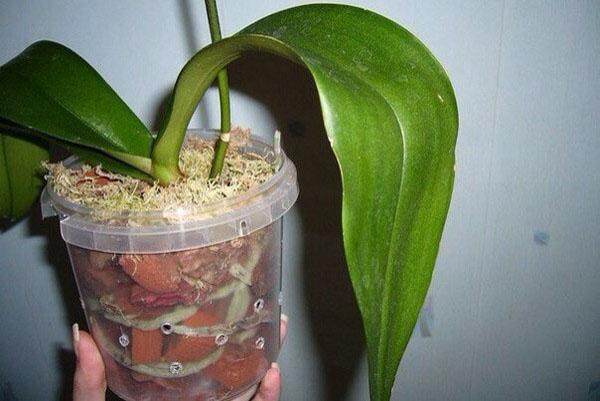Phalaenopsis orchid - butterfly flower needs special care
 The butterfly flower is loved by many gardeners. In order for the bush to delight with its beauty, the phalaenopsis orchid at home requires specific care. The epiphyte plant develops in conditions that are not difficult to create. Fulfillment of all maintenance requirements will be the key to long-term flowering of the orchid.
The butterfly flower is loved by many gardeners. In order for the bush to delight with its beauty, the phalaenopsis orchid at home requires specific care. The epiphyte plant develops in conditions that are not difficult to create. Fulfillment of all maintenance requirements will be the key to long-term flowering of the orchid.
Read also the article in the topic:orchid care and reproduction at home!
Phalaenopsis orchid care at home

Location for a flower pot - the shaded side of the apartment. Direct sunlight and a southern window are not suitable for an orchid. Plants can be placed far from the window, but with lighting. The length of the day is critical. Phalaenopsis orchid blooms only under illumination for at least 12 hours.
Content temperature when caring for a phalaenopsis orchid at home, it depends on the season. In summer, when flower arrows are striking in their beauty, it should be 18-25 in the shade 0 C. At higher temperatures, flowers can quickly begin to crumble. In winter, if flowering is not expected and the plant is resting, coolness is needed, about 15 degrees.
During the rest period, when flower buds are laid, the night temperature should be 4-5 degrees lower than the daytime.
How to water orchids phalaenopsis at home? The fleshy roots feed the plant, but they can rot if the moisture is stagnant. The roots must be in an ultra-light substrate and not only supply the plant with nutrients, but also produce chlorophyll under the influence of light penetrating the transparent walls of the vessel. It is important to saturate the substrate with moisture after it has dried by immersion for 30 minutes. In this case, you should not wet the leaves. It is possible to determine whether the soil in a pot is dry by weight, an indicator of moisture, everyone finds their own way of control. With a lack of moisture, the plant will shed flowers, with an excess, it will rot.
Microclimate for a flower - butterflies are created in all available ways. The orchid does not require regular spraying, the accumulation of water in the leaf axils can cause rotting. A moisture content of 40-45% is considered optimal for the plant.
Phalaenopsis orchid soil is selected with the expectation that the plant is epiphyte. The substrate is prepared from a mixture of coniferous tree bark, charcoal, sphagnum moss and shells. The bark is taken from old fallen trees, soft, after boiling. Pebbles are poured into the lower part, like drainage, with the addition of bark and coal. The acidity should be 5.5-6.0. To keep the acidic environment, a little peat is added to the substrate, or it is poured with water acidified with lemon juice. But it is better to do the transplant after two to three years and not use acidifiers.
For long flowering, when caring for the phalaenopsis orchid, you should not change the place of the pot and maintain a uniform temperature in the room. Fertilizers for orchids have a specific composition and concentration; they should be used once a month in the recommended amount. Root dressing for a healthy flower is preferred.
Leaves are required.You need to rinse them, then wipe them so that there are no drying droplets left. If the old lower leaves begin to dry out, they need to be cut off. Also observe the condition of the aerial roots, removing damaged parts. Be sure to sprinkle the cut with charcoal or cinnamon powder.
How to properly transplant Phalaenopsis orchid at home?
The roots of the orchid are not long, not branched, it is important that there are many of them, and they hold the plant firmly in the soil. The bush should not swing. In order for the root system to be healthy, the orchid must be transplanted correctly after it has faded.
 The stages of transplant include mandatory operations:
The stages of transplant include mandatory operations:
- remove the plant from the container with minimal damage;
- soak a clod of earth and wash it off with a stream of water;
- remove damaged roots, sprinkle the cut points with coal dust or cinnamon powder;
- cutting off dry leaves and arrows, you need to leave hemp;
- dry the flower 3 hours before planting.
Boil the composition of the soil and leave in water until it cools. Filter out the solid part, rinse on a sieve with hot water and put to dry until free flowing. Treat the drainage composition in the same way. Place the prepared dried plant in the center and sprinkle the roots with the substrate, without deepening the rosette along the neck. Drizzle with warm water and let the filtrate drain. The compacted and settled soil is brought up to the normal level by filling. There should be no moisture on the leaves and in the axils after transplanting.
The transplant operation is necessary in order not to deplete the mineral supply, not to increase acidity and not to use peat and acidified water, which will poison the plant. You can get acquainted with the transplant of the phalaenopsis orchid at home on the video, which will help not to make mistakes.
Home breeding methods for orchids
Phalaenopsis orchid is propagated by seeds in special conditions. At home, you can get a new copy by the rudiment formed on the faded arrow with aerial roots. This is the easiest way to get a new plant.
 There is another, more time-consuming way - grafting faded arrows. The cut arrows are cut into fragments, each of which contains a dormant bud. Cuttings are germinated in a substrate in a humid environment, not every cutting will give a new baby.
There is another, more time-consuming way - grafting faded arrows. The cut arrows are cut into fragments, each of which contains a dormant bud. Cuttings are germinated in a substrate in a humid environment, not every cutting will give a new baby.
The block culture method - reproduction of the phalaenopsis orchid at home, as an epiphyte, on a wooden base is applicable if a humid air environment can be created. On a piece of vine, a branch of a tree, moss or similar material is attached to retain moisture. A baby phalaenopsis orchid is pinned to this surface. To prevent the roots in the upper layer from drying out, the environment must be moist.
Diseases and pests of orchids
If you take care of the orchid incorrectly, then pest colonization and plant diseases are inevitable. Non-infectious orchid diseases arise from improper care, then the weakened plant is affected by insects and fungal and bacterial ailments. When orchid care phalaenopsis at home the first signal of trouble may be yellowing leaves.
 Yellowness indicates incorrect content temperature, lack of light or moisture. But the worst thing will be steaming or prolonged hypothermia of the plant. Vegetative buds die and the plant dies. Elongated leaves signal a lack of light and become vulnerable.
Yellowness indicates incorrect content temperature, lack of light or moisture. But the worst thing will be steaming or prolonged hypothermia of the plant. Vegetative buds die and the plant dies. Elongated leaves signal a lack of light and become vulnerable.
Viral diseases include all kinds of small spots and mosaics. They are incurable. Therefore, if a specialist has diagnosed a viral disease, the plant must be destroyed by burning. Viruses carry insects, and inevitably the disease will spread to other flowers.
Bacterial spotting manifests itself as dark spots, softened leaves and roots. Sore spots are cut out to healthy tissue, burned with iodine, and sprinkled with coal dust. In advanced cases, the leaves and roots are treated with fungicides.
 Anthracosis, powdery mildew, rust belong to fungal diseases, are transmitted by spores or with soil. Preventing these diseases is easier than curing them. To do this, you need to ventilate the room, avoid excessive moisture, do not leave droplets of water on the leaves. Various rot appears when the temperature regime is violated, especially with the greenhouse effect. A sooty mushroom develops on the sweet secretions of insect pests.
Anthracosis, powdery mildew, rust belong to fungal diseases, are transmitted by spores or with soil. Preventing these diseases is easier than curing them. To do this, you need to ventilate the room, avoid excessive moisture, do not leave droplets of water on the leaves. Various rot appears when the temperature regime is violated, especially with the greenhouse effect. A sooty mushroom develops on the sweet secretions of insect pests.
A weakened plant can inhabit aphids, mealybugs. With proper care, the mealybug will not start. Aphids should be washed off with soapy water. After processing, wash the leaves with soft water and dry. To destroy insects, use only the preparations recommended for orchids.
On this topic:orchid transplant at home!
Hello, I am happy to read your pages about flowers. I learned a lot of useful things, thank you very much!
tell me how to save the orchid, the leaves at the base darkened and fell off
I don't understand why she has roots with some kind of yellow bloom. Is it soil residues or is it really plaque? It seems that there are no traces of decay (blackness). Try to rinse them well, you can add potassium permanganate, and place in a fungicide solution. Change the soil. After a couple of days, wipe the remaining leaves with succinic acid.